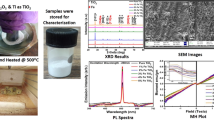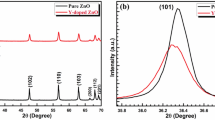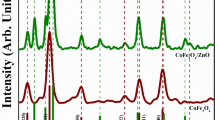Abstract
In this study, the electrical properties of ferroelectric liquid crystal (W206E) doped with anatase titanium dioxide (TiO2) nanoparticles were studied. The experimental results show that the dopant TiO2 reduces the free ion concentration and therefore the conductivity of doped W206E samples. This reduction in the free ion concentration is due to the trapping of free ions by TiO2 nanoparticles dispersed in W206E. The reduction in the free ion concentration is related to the doping concentration of TiO2. The experimental results show that the higher concentration of TiO2 is more effective in the trapping of mobile ions. This result will help in the development of fast response display devices with better contrast and low threshold voltage.
Access provided by CONRICYT-eBooks. Download conference paper PDF
Similar content being viewed by others
1 Introduction
Liquid crystal displays are the most widely used displays among the other existing displays in the display industry. But, nowadays the modern and sophisticated devices require displays with improvised properties such as higher contrast, low power consumption, faster response time and full color capability. The performance of the liquid crystal display devices is dependent mainly upon the purity of the used liquid crystal material. But it is a known fact that, some ionic impurities are always present in the liquid crystals that influences the various physical properties including the conductivity of liquid crystals [1]. The mobile ions in liquid crystal can originate during the synthesis of liquid crystal, due to the ionic dissociations of residual impurities present in liquid crystal, from the alignment layers and at the time of cell filling process [1]. These ionic impurities are mainly responsible for the poor performance i.e. slow response, higher operating voltage, poor contrast and image sticking of display devices [2]. Therefore, to improvise the performance of liquid crystal based display devices, the free ionic impurities present in liquid crystal must be minimized before using it for any display application. Doping of different types of nanoparticles such as semiconducting nanoparticle [3, 4], metallic nanoparticle [5, 6], ferroelectric nanoparticle [7, 8] and dielectric nanoparticle [9, 10] in liquid crystal has improved the various electro-optical properties of the existing liquid crystals. The insulating nanoparticles are generally used to reduce the free ions present in liquid crystal. In this study, we have doped the FLC W206E with TiO2 nanoparticles in two different concentrations and there after studied for different electrical properties.
2 Experimental
The phase sequence of the ferroelectric liquid crystal (FLC) W206E used in the present study is Crystal ↔ SmC*(86 °C) ↔ SmA (92 °C) ↔ N*(97.6 °C)↔ Isotropic. The TiO2 nanoparticles (particle size 18–23 nm) procured from Sigma Aldrich USA, were used to prepare two different FLC nanocolloids, W206E + 0.5 wt% TiO2 and W206E + 1.0 wt% TiO2. The TiO2 nanoparticles were taken in fixed proportion and mixed with W206E to prepare the FLC nanocolloids. The FLC nanocolloids were prepared using ultrasonication technique, where we have added chloroform to the mixture of W206E + TiO2 nanoparticles and then sonicated till the dispersion was visibly homogeneously mixed. After that the dispersion was left at temperature ~45 °C, till the chloroform evaporated completely in order to get FLC nanocolloids. The homogeneous liquid crystal cells were prepared using photolithography and conventional rubbed polyimide technique. The thickness of the cells was maintained ~3.4 μm using Mylar spacer. The pure and FLC nanocolloids were introduced into the liquid crystal cells at their isotropic temperatures by means of capillary action.
These filled cells were studied for electrical properties. The conductivity measurement from 20 Hz to 25 kHz and dielectric measurements in the frequency range of 500 to 105 Hz, were carried out at different temperatures using Agilent E4980A LCR meter. The temperature controller INSTEC mK-1000 was used in this study.
3 Results and Discussion
3.1 Conductivity
To investigate the effect of doping of TiO2 nanoparticles on electrical properties of pure W206E and FLC nanocolloids, W206E + 0.5 wt% TiO2 and W206E + 1.0 wt% TiO2, the conductivity measurements were carried out at ~40 °C. The results are shown in Fig. 1. The observed results clearly show that the conductivity of doped samples is decreased as compared to pure W206E. The decrease in the conductivity is more significant at higher doping concentration of TiO2 nanoparticles in W206E. This can be explained on the basis of ion trapping phenomenon [11], where TiO2 nanoparticles trapped the mobile ions present in pure W206E. Since the number of TiO2 nanoparticles will be more in case of high doping concentration of 1 wt% as compared to the lower doping concentration of 0.5 wt%. Therefore, we can expect more trapping of ions in case of 1 wt% TiO2 as compared to 0.5 wt% TiO2 and hence the conductivity of W206E + 1.0 wt% TiO2 is less than the W206E + 0.5 wt% TiO2.
3.2 Dielectric Measurement
In the lower frequency region, the dielectric measurements can give valuable information about the mobile ions present in liquid crystalline material. Therefore, to further substantiate the effect of mobile ions on the observed conductivity results, we have carried out dielectric measurements in the lower frequency region in the SmC* phase of each sample from 500 to 105 Hz between the temperature range 30–65 °C. The observed dielectric loss (ε″) results for pure and doped samples are shown in Fig. 2. The conductivity of liquid crystal σ = nqµ, is mainly dependent upon the concentration of ions (n), charge (q) and mobility (μ = qD/k b T, where D is diffusion coefficient, k b is Boltzman’s Constant and T is the temperature). To calculate the concentration of ions (n) and diffusion coefficient (D), we have fitted the dielectric data with Uemura formalism given in (1) and (2) [12, 13] in the SmC* phase of each sample.
where, q is charge, d is the separation between electrodes and A = d(ω/2D)1/2. The concentration of ions and diffusion coefficient are calculated from the fitting of dielectric loss data using (2) and are shown in Fig. 3. Figure 3a, b clearly show that the concentration of ions and diffusion coefficient for W206E + 1.0 wt% TiO2 is lower than the W206E + 0.5 wt% TiO2 and pure W206E samples. The decrease in the concentration of ions in FLC nanocolloids is due to the trapping of mobile ions present in FLC host by TiO2 nanoparticles. The trapping of mobile ions will be more for the higher doping concentration of 1.0 wt% TiO2 as compared to 0.5 wt% TiO2 in pure W206E. Further, as shown in Fig. 3b, the diffusion coefficient also decreases for the FLC nanocolloids in comparison to pure FLC. This decrease is more significant for high doping concentration of 1 wt% TiO2 in comparison to 0.5 wt% TiO2. The decrease in the value of diffusion coefficient may be attributed to the strong interaction between the charged particles and the increased viscosity of the FLC nanocolloids [14]. According to Einstein-Stokes theorem, the diffusion coefficient (D) is given by (3);
where, k b is Boltzmann’s constant, T is temperature, η is viscosity of the medium and R is the radius of particle. In (3), all other quantities except η are constants. The viscosity (η) of the liquid crystal medium can be changed by the doping of nanoparticles in liquid crystal material. From (3) it is clear that, if the viscosity increases, then the value of diffusion coefficient will decrease and vice versa. Also, it is known that the activation energy of the system increases with increasing viscosity. To further substantiate this we have calculated the activation energy for pure W206E and FLC nanocolloids using (4).
where, D 0 is constant and E a is activation energy. Figure 4, shows that the activation energy of nanoparticle dispersed ferroelectric liquid crystal systems is increased as compared to pure W206E and it is maximum for W206E + 1.0 wt% TiO2. This fact suggests that the viscosity of W206E + 1.0 wt% TiO2 is higher than W206E + 0.5 wt% TiO2. Therefore, from these observations we believe that the strong interactions between charged particles and increased viscosity are the main reasons for the decrement in the value of diffusion coefficient (D) for FLC nanocolloids.
We have also calculated the conductivity at different temperatures for pure and both doped system using (5) and
the results are shown in Fig. 5. The observed results show that the conductivity of FLC nanocolloids is lower than that of pure W206E. The lowest value of conductivity was observed for W206E + 1.0 wt% TiO2. The current study supports the fact that, the conductivity of doped systems was decreased due to the trapping of mobile ions by doped TiO2 nanoparticles.
4 Conclusion
The pure and TiO2 nanoparticle dispersed ferroelectric liquid crystal systems were studied for electrical properties and mobile ion concentration. The conductivity measurements show that the conductivity of the FLC nanocolloids has decreased as compared to the pure W206E. Further, with the help of dielectric measurements and Uemura formalism, the concentrations of ions and diffusion coefficient have been calculated and both of these parameters were decreased with the increase in the doping concentration of TiO2. The decrease in ions concentration is attributed to the mobile ions trapping phenomenon while the reasons considered for the reduction in the value of diffusion coefficient are strong interactions between charged particles and increased viscosity of the FLC nanocollids. This study will help to improve the performance of liquid crystal displays by reducing the unwanted mobile ion effects.
References
Basu, R. and Garve, A., “Effects of ferroelectric nanoparticles on ion transport in a liquid crystal,” Appl. Phys. Lett. 105, 151905 (2014).
Garbovski, Y. and Glushchenko, I., “Nano-objects and ions in liquid crystals: ion trapping effect and related phenomena,” Crystals, 5(4), 501–533 (2015).
Supreet, Kumar, S., Raina, K.K. and Pratibha, R., “Enhanced stability of the columnar matrix in a discotic liquid crystal by insertion of ZnO nanoparticles,” Liquid Cryst. 40, 228–236 (2013).
Shukla, R.K., Galyametdinov, Y.G., Shamilov, R.R. and Haase, W., “Effect of CdSe quantum dots doping on the switching time, localised electric field and dielectric parameters of ferroelectric liquid crystal,” Liquid Cryst. 41, 1889–1896 (2014).
Podgornov, F.V., Ryzhkova, A.V. and Haase, W., “Influence of gold nanorods size on electro-optical and dielectric properties of ferroelectric liquid crystals,” Appl. Phys. Lett. 97, 212903 (2010).
Mandal, P.K., Lapanik, A., Wipf, R., Stuehn, B. and Haase, W., “Sub-hertz relaxation process in chiral smectic mixtures doped with silver nanoparticles,” Appl. Phys. Lett. 100, 073112 (2012).
Kumar, P. and Sinha, A., “Effect of barium titanate nanoparticles of different particle sizes on electro-optic and dielectric properties of ferroelectric liquid crystal,” Phase Trans. 88, 605–620 (2015).
Ouskova, E., Buchnev, O., Reshetnyak, V., Reznikov, Y. and Kresse, H., “Dielectric relaxation spectroscopy of a nematic liquid crystal doped with ferroelectric Sn2P2S6 nanoparticles,” Liq Cryst. 30, 1235–1239(2003).
Tang, C.Y., Huang, S.M. and Lee, W., “Electrical properties of nematic liquid crystals doped with anatase TiO2 nanoparticles” J. Phys. D Appl. Phys. 44, 355102 (2011).
Kumar, P, Kishore, A. and Sinha, A., Effect of different concentrations of dopant titanium dioxide nanoparticles nn electro-optic and dielectric properties of ferroelectric liquid crystal mixture,” Adv. Mater. Lett. 7(2), 104–110 (2016).
Shukla, R.K., Liebig, C.M., Evans, D. R. and Haase, W., “Electro-optical behaviour and dielectric dynamics of harvested ferroelectric LiNbO3 nanoparticle-doped ferroelectric liquid crystal nanocolloids,” RSC. Adv. 4, 18529–18536 (2014).
Uemura, S., “Low-frequency dielectric behavior of poly(vinylidene fluoride),” J. Polym. Sci., Polym. Phys. Ed. 12, 1177 (1974).
Sawada, A., Tarumi, K., and Naemura, S., “Novel Characterization Method of Ions in Liquid Crystal Materials by Complex Dielectric Constant Measurements,” Jpn. J. Appl. Phys. 38, 1423 (1999).
Yadav, S.P., Manohar, R. and Singh, S., “Effect of TiO2 nanoparticles dispersion on ionic behaviour in nematic liquid crystal” Liquid Cryst. 42, 1095–1101(2015).
Acknowledgements
The Department of Science and Technology (EMR/2015/001897), Govt. of India is gratefully acknowledged for providing the necessary experimental facilities to conduct the experiments at IIT Delhi, India.
Author information
Authors and Affiliations
Corresponding author
Editor information
Editors and Affiliations
Rights and permissions
Copyright information
© 2017 Springer Nature Singapore Pte Ltd.
About this paper
Cite this paper
Kumar, P., Sinha, A. (2017). Effect of TiO2 Nanoparticle Doping on the Electrical Properties of Ferroelectric Liquid Crystal. In: Bhattacharya, I., Chakrabarti, S., Reehal, H., Lakshminarayanan, V. (eds) Advances in Optical Science and Engineering. Springer Proceedings in Physics, vol 194. Springer, Singapore. https://doi.org/10.1007/978-981-10-3908-9_61
Download citation
DOI: https://doi.org/10.1007/978-981-10-3908-9_61
Published:
Publisher Name: Springer, Singapore
Print ISBN: 978-981-10-3907-2
Online ISBN: 978-981-10-3908-9
eBook Packages: Physics and AstronomyPhysics and Astronomy (R0)









